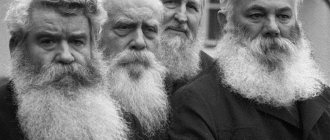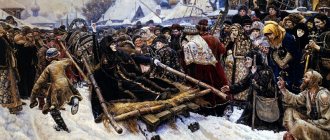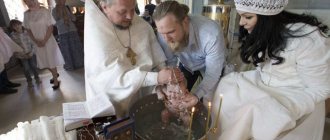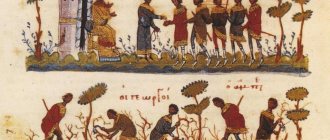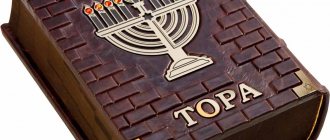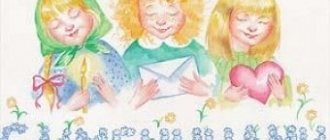The Helmsman of 1620 contains the following extremely interesting section. I present it in the same form as it appears in Kormchay, without translation into modern Russian. Necessary explanations have been added in parentheses. “About the books of the Old Law and the New Law. The essence of the Old Testament books is 22. Much of what we hear is imagined from the Jews (emphasis added by the author).
Genesis, Exodus, Eugites, Numbers, Second Law, Joshua, Judges, Ruth, Four Kingdoms, then the Remnants (that is, the books of Chronicles - Author)› then the two Ezra, Psalter, Proverbs, Churchman (Ecclesiastes - Atfra.) , Song Book (Song of Songs - Author) in Job, Prophetic 12: first - Josiah, 2 - Amos, 3 Micah, 4 - Joel, 5 - Jonah, 6 Obadiah, 7 - Nahum, 8 - Habakkuk, 9 - Zephaniah, 10 - Haggai, 11 - Zechariah, 12 - Malachi; therefore Isaiah, Jeremiah, Baruch, Lamentations, Epistles, Ezekiel, Daniel. This is the Old Testament.
But again, I’m not too lazy to decide (that is, I’m not too lazy to list the composition of the New Testament - Author).
Four Gospels - Matthew, Mark, Luke, John; Acts of the Apostles, Seven Epistles of the Council and the Apostle: One of James, two of Peter, three of John, one of Judah, Paul's Epistles 14: first Romans, two to Corinth, to Galatians, Ephesus, Philippisi, Kolasai, to Thessalonians, two to Hebrews, Timothy, two to Titus, to Philemon; the final Revelation of John (APOCALYPSE - Author), John Chrysostom, John of Damascus, John the Theologian, Gregory the Decapolite, Cyril of Alexandria, Dionysius the Areopagitic, Simeon the Receiver of God, Isaiah the Great (New Testament Isaiah! And in the Bible placed in the Old Testament - Author), Jeremiah (New Testament Jeremiah! And in the Bible he is in the Old Testament - Author), DANIEL (New Testament Daniel! And again classified in the Bible as the Old Testament - Author), Chronicles (New Testament books of Chronicles! Rearrangement in the Old Testament according to the Biblical text - Author), Deftoronomia, Apocalypse (that is, a certain OTHER APOCALYPSE, since the Revelation of John has already been listed above - Author), Varlam, Ephraim, Pan-dok, Limonis, Paterik, Nile, Asaph, Maxim, Paul of Mona-Casia, Basil the New, Granograph (hence, a certain CHRONOGRAPH was part of the New Testament; where is this New Testament Chronograph today? - Author), Palea, Ecclesiastes (New Testament Ecclesiastes! And again dragged into the Old Testament. - Author), Shestodnevets, Genealogy, Streams, Depth, Beads, Krinitsa, Joseph Matafin, Cosmas Indicoplov , Anastasius of Sinai, Athanasius the Great, Apostolic, Joshua (New Testament Joshua turns out to be! Could it be the medieval cannons of the Jericho chimneys from which the walls fell? - Author), Jesus Semeramin, Jesus Sirakhov (New Testament Jesus! I'm tired of repeating myself about the Bible - Author), three Polls, Physilog twelve, Iyakovlich, Job (New Testament Job! Yes, this is no longer an option! - Author), Nifont, Bee, Inflower, Stoslov, Wanderer.”
Most of these books were destroyed by the priests, some ended up in the apocrypha. However, the Old Believers managed to preserve the heritage of their ancestors and ancient books
gradually they see the world again. The author of the miniature has the opportunity to read them, being an Old Believer of the family ancestral Christianity of the Cathars of Languedoc and the Kulugurs of the Volga Cup-makers. We are also called the Good People of the Holy Grail (Chalice).
What we see is amazing at where the cunning priests and the state crooks they serve have led humanity. There is nothing Christian about what today appears to be the Eastern and Western Christian churches except in name. This is the religion of Satanail, not even a faith, but simply a way of controlling people. Judeo-Christianity in the most perverted form of obscurantism.
I have no right to impose my opinion on readers, my Faith is a voluntary matter, but the published list of books of Holy Scripture should make you wonder why, out of such a huge amount of knowledge, you only receive an ersatz excerpt of biblical history based on the teachings of the Torah.
But the Torah even rejects Judeo-Christianity, where the symbol is a scene of torture and an instrument of execution worn around the neck. You wear a yoke, man, a shameful yoke of a slave. Look at the ancient monuments with the cross. Where do you see the crucifix on them?
The epic of Christ is a real event of the 12th century that has a grandiose meaning and an instructive conclusion, in the form of a teaching on how to return to the house of the Almighty. Today you do not know the teachings of Christ, but what this teaching about Christ is given to you, from the point of view of the Torah, Talmud and other wisdom. You are a blind man. Let this short work open your eyes to how the Makawa priests are deceiving you.
There are no exact, canonically approved rules for performing home worship. However, in our case, if you are far from the church, you should use every opportunity to bring home worship closer to church services. This must be done, of course, in accordance with one’s own strengths, knowledge and on the advice of one’s spiritual father.
People who have recently come to the Church, who do not have books and cannot read Slavic, should memorize the basic prayers: the Jesus Prayer
, “
Our Father
”, “
It is worthy to eat
”, “
Trisagion
”.
With the help of these prayers and bows, you can fulfill a household rule or even the entire daily liturgical circle. The regulations for performing the service with bows and prayers are contained in the book Prayer Book,
published by the Old Believer Metropolis. In the absence of such a book, you can ask any Old Believer clergyman and clergyman about the order of reading the indicated prayers and bows. It is better to discuss the number of prayers and bows of the house rule with your spiritual father, who knows the level of your spiritual and physical fitness.
Old Believers - who are they?
Old Belief arose in the 17th century as a protest against changes in old church customs and traditions. A schism began after the reforms of Patriarch Nikon, who introduced innovations in church books and church structure. All who did not accept the changes and advocated for the preservation of old traditions were anathematized and persecuted.
The large community of Old Believers soon split into separate branches that did not recognize the sacraments and traditions of the Orthodox Church and often had different views on the faith.
Avoiding persecution, the Old Believers fled to uninhabited places, settling in the North of Russia, the Volga region, Siberia, settling in Turkey, Romania, Poland, China, reaching Bolivia and even Australia.
Customs and traditions of the Old Believers
The current way of life of the Old Believers is practically no different from the one that their grandfathers and great-grandfathers used several centuries ago. In such families, history and traditions are respected, passed down from generation to generation. Children are taught to respect their parents, brought up in strictness and obedience, so that in the future they become a reliable support.
From a very early age, sons and daughters are taught to work, which is held in high esteem by the Old Believers. They have to work a lot: Old Believers try not to buy food in the store, so they grow vegetables and fruits in their gardens, keep livestock in perfect cleanliness, and do a lot of things for the house with their own hands.
They do not like to talk about their lives to strangers, and even have separate dishes for those who come into the community “from the outside.”
To clean the house, use only clean water from a blessed well or spring. The bathhouse is considered an unclean place, so the cross must be removed before the procedure, and when they enter the house after the steam room, they must wash themselves with clean water.
Old Believers pay great attention to the sacrament of baptism. They try to baptize the baby within a few days after his birth. The name is chosen strictly according to the calendar, and for a boy - within eight days after birth, and for a girl - within eight days before and after birth.
All attributes used in baptism are kept in running water for some time so that they become clean. Parents are not allowed to attend christenings. If mom or dad witnesses the ceremony, then this is a bad sign that threatens divorce.
As for wedding traditions, relatives up to the eighth generation and relatives “on the cross” do not have the right to walk down the aisle. There are no weddings on Tuesday and Thursday. After marriage, a woman constantly wears a shashmura headdress; appearing in public without it is considered a great sin.
Old Believers do not wear mourning. According to customs, the body of the deceased is washed not by relatives, but by people chosen by the community: a man is washed by a man, a woman by a woman. The body is placed in a wooden coffin with shavings at the bottom. Instead of a lid there is a sheet. At funerals, the deceased is not remembered with alcohol, and his belongings are distributed to the needy as alms.
There is no Israel in the original Ostrog Bible
DISTORTION OF THE OSTROG BIBLE.
When reading the handwritten Ostrog Bible of 1581, attention is drawn to the obvious discrepancies between the key names in the handwritten Ostrog BIBLE and its translation into modern Russian. If you follow the handwritten version, it turns out that ISRAEL DID NOT EXIST. INSTEAD OF ISRAEL, THE COUNTRY WAS CALLED JELIAH. THERE WAS NO “JUDIAN” FAITH, SO THE OLD RELIGION OF “ELI” WAS REVIVED BY JAMES IN HONOR OF THE GOD ELI.
The Ostrog Bible is an ancient handwritten work from 1581, written in Church Slavonic. The Bible contains the Old Testament, which consists of 5 books: Genesis, Exodus, Leviticus, Numbers, Deuteronomy. Its literal translation into modern Russian can be read on the website “patriarchia.ru”.
In the book “Numbers” of the Ostrog Bible of 1581. You will not find the term “Israel”; instead, there is the term “Iel”. You will not find the term “sons of Israel”; instead, there is the term “sons of Eli ”, which means belonging to the god ILI. Jacob said “keep foreign gods away and put earrings on your ears” (Genesis 32, 35) and called for a RETURN TO FAITH IN ELIJAH. One night Jacob had to fight with the god ELIJAH himself. God told him: from now on your name will not be Jacob, “you will be Ilem,” for you have fought with God, and you will overcome men. And the more precise name of IIL (“Iil” in the Ostrog Bible) is IeIL, which follows from the list of 5000 words replaced in the Bible, published by Archimandrite Nikiforov. IeIl only makes sense in Russian, obviously it is “Sie Il”.
Now, when you open a query on the Internet about the books of the Bible, you get the answer that this is a biblical tradition about the Jews and in brackets - “Israelites,” meaning modern Israel and modern Jews. But in Numbers the term “Jews” is absent altogether.
In "Numbers" it turns out that among the participants in the exodus there is no clan with the name "Jews". It lists the following 12 ancestors of the tribes, “chosen men”: Reuben, Simeon, Judah, Issachar, Zebulun, Joseph, Benjamin, Dan, Assir, Gad, Naphtali, Levi. Their great-grandchildren became participants in the “exodus” military campaign of conquest and headed each of their own camps. But in the list of names of sons there is also no name of the genus “Eur”. There is “Eber”, but it used to be written “Aver” - “Aved” and clearly meant someone who does not live according to the Vedas, not according to faith, that is, an unbeliever (see 5000 words replaced in the Bible, Nikephoros).
In the book of Genesis of the Ostrog Bible (chapter 42) the term “Hebrew” appears only once as a nickname for “sheep”. In Genesis, the Egyptians disdained to sit down with the Hebrews (Joseph's brothers) to eat food, since they were shepherds of sheep. "Eurrenos" is ancient Greek for "good sheep". This means that the sons of Eli were sheep farmers and nothing more.
Why does no one notice such a radical substitution of words in the printed edition of Genesis ch. 14 of the “Old Testament”, where it is written “Abraham the Jew”, and in the “Ostrog Bible” “Abram the stranger”.
In the book of Exodus, the term “Hebrew” (“Evraanyn”, “Evraom”) is obviously used in the form of a nickname for the sons of Iel (the sons of Israel) - “sheep breeders” - “sheep breeders” 10 times only in chapters 1, 2, 5 out of the available 40 chapters. For those who do not understand, in chapter 4 there appears a clarification in parentheses “The Lord (the God of the Jews).” If the sons of Eli are sheep farmers, then it is natural that ram sheep are symbolic characters of the Eli ("Jewish"), Christian and Greek religions. The Greek Argonauts mined the golden fleece of the ram. Christ is called the lamb of God (lamb), “sheep.”
It is highly likely that the ancestors of modern Jews borrowed the name “Jews” from the nickname of the Iiliev-“Jew-ane”. Only the Egyptians (not modern Egypt, modern Egypt is called Misr) called the Iilis “Eur-ane”, meaning only their craft or nickname, and not the name of the clan. The Egyptians, as relatives, gave shelter to the “Elilis” for 400 years, who, due to famine, had to leave their homes and settle in Egypt.
In the book of Leviticus the term “Jews” is never found, and only the expression “sons of Eli” is present in the Ostrog Bible.
In the book of Deuteronomy the term "Hebrew" appears only once. Repeated many times in the text, “brother” suddenly receives a clarification - “your brother, a Jew, or a Jew...” in Ch. 15 Ostrog Bible. In the modern Old Testament these terms already appear with a capital “Jew or Hebrew Woman.” When reprinting the Bible, the nickname is turned into a genus name.
In the additional 5 books of the Old Testament: Joshua, Book of Judges, Ruth, Second Book of Kings, Third Book of Kings, the term “Jews” is completely absent. In the First Book of Samuel, “Hebrews” appears 4 times. That’s what they were called by the Philimites (the Philimites are considered Palestinians, Hellenes), by a nickname. If the Philimites are Hellenes, then this once again proves that “Jews” (sheep) is a Greek word.
From all of the above it follows that the name of the Old Testament people is “SONS OF HEL.” And that’s what they called THEMSELVES. And the Lord also calls them only the sons of Elijah and nothing else. And “Jews” are just the profession of “sheep breeders” from the ancient Greek “eurrenos”. That is, shepherds of sheep. The Egyptians and Philimites called them that, which means that these Egyptians and Philimites spoke ancient Greek.
A similar radical substitution occurred with the term “Judaizers” in the Ostrog Bible (Genesis). In the modern edition of the Bible, all “Judaizers” are replaced by “Jews.” “Zhidi” in Kolyma slang simply means “forest devil”, “devil”, grandfather-did (Internet). There is a phrase - “a certain Jew, a sorcerer, a sorcerer and a charmer has appeared,” that is, a “Jew” - a damn sorcerer. Under Ivan the Terrible, the main “kikes” were only Russians Ivan Maksimov, Volk Kuritsin, Dmitry Konoplev (they were all executed). Even the fighter against the heresy of the Judaizers, Joseph Volotsky, turns out to be Ivan Sanin, and he himself considers it an honor to be called by the Old Testament middle name Joseph. The Judaizers came out in defense of their faith and did not recognize Christ as the son of God. It is unclear what they themselves called their faith, there is no specific name for their faith anywhere, the believers themselves never called themselves “Jews,” but there is a specific name for “Judaizers” - Magi and Sorcerers (sorcerers). They were against the introduction of the young Christian religion, which in essence is also the Illyan-Illyrian faith, but with the deification of Christ. Christianity began the fight against the old religion and its preachers - magi, magicians, sorcerers, soothsayers, witches, “Judaizers” and achieved great success. Remember how in Kuprin’s story “Olesya” the parishioners of the church stone the girl Olesya because she is not a Christian, but a sorceress.
It is noteworthy that in the Old Testament in the book of Genesis only in one chapter Joseph suddenly begins to be called a Jew. He was suddenly called a Jew when it was necessary to interpret the Pharaoh’s dream and predict his future—to do some magic. In addition to Joseph, the Magi were invited. Joseph here also acted as a Magus. Magi living in the forest were called “zhidi” - “forest devils” in Siberia. The thorn tree in Dahl’s dictionary is called “Jew” and was called that way even before Christ. Apparently he had some kind of ritual role among the Magi. For some reason, the wreath on Christ’s head was made of thorns. Why did it even have to come up with the idea of wearing a wreath during an execution? And this is not just improvisation, but a semantic sign invented in advance. Mocking him as a soothsayer, a sorcerer? The loser's prickly thorn instead of the winner's laurel wreath? Or simply make the suffering worse. The very custom of putting on a wreath was brought to the Mediterranean by the newly arrived Greeks. This custom is widespread among the Slavs, especially among the Western ones.
The Iilian faith might have survived to this day in veneration if the government had not changed. Svyatoslav, having taken away power from the Khazars and becoming the head of Khazaria instead of the “Kagan,” did not want the new elite to have the faith of the vanquished and the very name of Khazaria. And the fault of the old “Ilirian”-“Ilian” religion was only that it was preached by the old “elite”. In addition, this religion is MILITARY, necessary in conditions of conquest with cruel military rules set out in the Old Testament. For unity, a new faith of humility-compromise-Christianity was required, which Svyatoslav’s mother, Princess Olga, actively began to introduce. The appearance in Christianity of such a negative character as the traitor Judas, who so successfully and accidentally coincided with the name of the founder of the country of Judea, played its part in the discrimination of “Ilirianism” (“Judaism”). Judas suddenly passed away (such a valuable witness hanged himself). This speaks of far from spontaneous, but well-thought-out staged events associated with the introduction of Christianity. For example, the arrival of the Magi to Mary announcing to everyone the birth of God’s son, which looks like preparing public opinion.
All 12 clans together called themselves the single name “sons of Elijah” and nothing else, neither Jews nor Jews. What did they call their faith? If they are the “sons of Eli”, then it should be called “Ili” or “Ilyria”, or “Iel”, “Jeel”, by analogy with Christianity by the name of Christ. Western historians began to call it “Jewish” in printed publications, making it generally accepted.
How the cult of Elijah was formed. Judging by the text of the Old Testament, it’s hard. The fact is that the entire people of the Exodus came out of “Egypt”, where they lived for 430 years, with a complete “set” of all the Egyptian gods: Baal, Astarte, Astaroth, Dagon, faith in the calf, with the Magi, soothsayers and fortune-tellers. There was no Ilya yet. Moses and Aaron, in the process of forming a military organization, proposed the cult of the Lord. They communicated with the Lord individually in the tabernacle with the ark and communicated the will of the Lord on their own behalf. But apparently this was not enough. On behalf of the Lord, during the Exodus, the ancestor Jacob (Someone?) with the name Il was deified, as the ancestor of the ruling military “elite” from his 12 sons in the people of the Exodus. So gradually the people began to call themselves “the sons of Eli,” which later turned into the belief and veneration of Eli as a deity. Thus, united by the common hardships of the Exodus and the common history of the Exodus, and further victories, the people united under the name Elijah.
How did the “substitution” of the heroes of the Bible and the heroes of the history of the Khazars take place with the history of the “ancient Jews”? Apparently it all started with the assignment by the ancestors of modern Jews of a name taken from the nickname “Iiliev” - “Jew-anin” - “sheep” (disheveled, shaggy) precisely in the 900s of the heyday of the power of the Khazars and, conversely, just at this time, extremely humiliated the situation of Palestinian “proto-Jews” persecuted from Armenia. The author Halevi in “Kuzari,” describing their true position in society in 900, calls them “few,” “humiliated,” “pathetic,” “with universal dislike for them” people (lines 4, 12). Kuzari said: “... it is enough that everyone is struck by their humiliated position, their small number and general dislike for them” (paragraph 4). In paragraph 12, Kuzari says: “I was not going to ask the Jews because I knew that from their pitiful situation they had forgotten about their past, and humiliation and poverty did not allow them to rise morally.” Having borrowed the “Illyrian” religion from the Khazars for their national self-affirmation, they gave it a new name - “Judaism.” They also began to call themselves by Old Testament names.
The religion of the Khazars, according to the Old Testament, is called “Ilian”, logically named after the deity Ilya, which is proven by the presence of the CULT OF ELIYA. CULT OF ELIJAH among the Greeks, Slavs, and Rus. The name of Elijah is in the title of the Greek “Iliad”, in the name of the Khazar capital Itil, in the name of the land of Illyria on the Balkan Peninsula, in the name of Israel, the dying words of Jesus Christ were also addressed to Elijah (“Either, Eli, lama sabachthani”) and Princess Olga , mother of Svyatoslav, built the first temple in honor of Elijah. The cult of Elijah the Prophet is popular in Rus'; it is no coincidence that the day of his veneration coincides with July 19 according to the old Julian calendar. The very name of the month of July coincides with the name Jeel and the surname of the Roman Julius dynasty. Notice that Jesus calls out to Eli before his execution, not Jacob, not Yahweh, not Israel. This means that the true name of the god is IL, as in the Ostrog Bible, and not in its reprints.
But the ancestors of modern Jews, when they adopted it, for some reason called it “Jewish” after the name of the country of Judea. Judah is the conquered lands that were given during the division between the “sons of Jel” specifically to the clan of Judah. There, in Judea, David (DVD) temporarily hid when he was pursued by King Saoul of Elijah. Agree, this is a strange name for a religion named after either the country of Judea, or the name of Judah, who also preaches faith in the god Elijah. The reason for renaming a religion when borrowing is unclear. Most likely they encountered immigrants from Judea. Judah temporarily separated from Elijah. In the Second Book of Samuel, David unites Judah and Elijah at age 30.
Having borrowed everything from the Khazars, the ancestors of modern Jews became contenders for participation in biblical events, and then began to be associated only with them. And after replacing “Ilirianism” with Christianity and the Khazars having sunk into oblivion, they generally turned from “phantom stand-ins” into real participants in biblical events, never taking part in them, but only sacredly believing in it.
But just when the handwritten OSTROZH Bible was reissued into a printed version, there was a slight replacement of “the sons of Eli” with “the sons of Israel”, and additionally more often the clarifying terms “Jews” were inserted into the text (one such note was even preserved for inserting this word in the page margin ), and in parentheses the clarification “Lord (Jewish God)” was introduced, “Judaizers” and “aliens” were replaced by “Jews”. AND EVERYTHING CHANGED DRAMATICALLY. And now the huge warlike people “Iil” disappears into oblivion, and the small unknown people who once called themselves “Jews” in 900. according to the ancient Greek name of the profession of the Illyrians, “eurrenos” (sheep breeders), and their state “Israel” in 1948, suddenly turns into the missing Illyrians. And now the entire Old Testament history involuntarily belongs to them, all the heroes, all the exploits and all the conquests (!) and even God. Although Joshua, before his death, punished: “Serve the Lord God of Israel” (chapter 14 Joshua). And regarding the conquests, it is known that the ancestors of modern Jews were landless wanderers until, after the Second World War, they were allocated a part of Palestine by the world community in 1948, called Israel.
Now try replacing “Jews” with “Elijev” in the ancient historical chronicle.
2016 February. SOURCES: “Kuzari” by Halevi, “Turks and Khazars” by M.I. Artamonov, “Old Testament” website “patriarchia.ru,” Ostroh Bible 1581. in the original.
What kind of cross do the Old Believers have?
In church rituals and services, Old Believers use an eight-pointed cross, on which there is no image of the Crucifixion. In addition to the horizontal crossbar, there are two more on the symbol.
The top one depicts a tablet on the cross where Jesus Christ was crucified, the bottom one implies a kind of “scale” that measures human sins.
How Old Believers are baptized
In Orthodoxy, it is customary to make the sign of the cross with three fingers—three fingers, symbolizing the unity of the Holy Trinity.
Old Believers cross themselves with two fingers, as was customary in Rus', saying “Alleluia” twice and adding “Glory to Thee, God.”
For worship they dress in special clothes: men put on a shirt or blouse, women wear a sundress and a scarf. During the service, Old Believers cross their arms over their chests as a sign of humility before the Almighty and bow to the ground.
Where are the settlements of the Old Believers?
In addition to those who remained in Russia after Nikon’s reforms, Old Believers who have lived for a long time in exile outside its borders continue to return to the country. They, as before, honor their traditions, raise livestock, cultivate the land, and raise children.
Many people took advantage of the resettlement program to the Far East, where there is a lot of fertile land and there is an opportunity to build a strong economy. Several years ago, thanks to the same voluntary resettlement program, Old Believers from South America returned to Primorye.
In Siberia and the Urals there are villages where Old Believer communities are firmly established. There are many places on the map of Russia where the Old Believers flourish.
A little about home prayer regulations
A somewhat more difficult task is home worship using special liturgical books. Experience shows that at home it is almost impossible to recreate the full daily cycle of worship, however, performing church services on Sundays and major holidays seems to be a completely feasible task. For a full-fledged divine service (i.e. Vespers, Vespers, Matins, Hours and Liturgy) certain knowledge in the field of the Rule and a complete set of liturgical literature are required. Specialized liturgical calendars published by various Old Believer consensuses can be of great help in this matter. There are simple and understandable instructions for holding services on a particular holiday.
In the absence of any liturgical books, it is possible to replace parts of the service with kathismas or canons. For services such as the Hours and the canon on a Sunday or holiday, it is enough to have a book of Hours and a collection of canons, so they can be read in full at a distance from the church. Also, in the context of home prayer, it is permissible to replace singing with reading.
By and large, home worship can approach the monastic service, performed either according to the Jerusalem Rule (using liturgical books) or according to the skete Rule (with replacement of parts of the service by the reading of the Psalter, the Jesus Prayer, or bows). It also happens that in home prayer it is easier to follow the requirements of the Church Charter than in a parish church. Let's say, if a relatively recent tradition has been established in churches to perform Matins in the evening, then no one bothers at home to follow the requirements of the Rule and pray Matins as it should be - in the morning. You can also follow the instructions of the charter regarding the time of other services, which in parishes, for the convenience of believers, are held at other times.
Why were the Old Believers called Bespopovtsy?
The split of the Old Believers formed two separate branches - priesthood and non-priesthood. Unlike the Old Believers-Priests, who after the schism recognized the church hierarchy and all the sacraments, the Old Believers-Priestless began to deny the priesthood in all its manifestations and recognized only two sacraments - Baptism and Confession.
There are Old Believer movements that also do not deny the sacrament of Marriage. According to the Bespopovites, the Antichrist has reigned in the world, and all modern clergy is a heresy that is of no use.
Liturgical books: Lenten and Colored Triodion, Menaion, Apostle, Gospel and Bible
Lenten Triodion, Colored Triodion and twelve volumes of Monthly Menias
contain changing parts of the service: canons for holidays and saints, troparia and kontakions, stichera. A complete set of these books is rarely used in home worship due to the great bulkiness of such a liturgical library - 14 large-format books. These books are used during worship in the temple. It makes sense to purchase these books if you are creating a public prayer house with a room specially designated for these purposes. At home, it is better to purchase the Festive and General Menaia. The first book contains the moving parts of the services for the twelve and other major feasts, and the second contains special canons, stichera and troparia that can be used when worshiping any saint.
Also in household use, various collections of prayer canons for holidays and selected saints are widely used. Reading such canons does not require special knowledge of the church charter and therefore can be recommended for home prayer to any Christian. Apostle and Gospel are required for worship and home reading.
and
the Bible
(Ostrozh edition by Ivan Fedorov).
The Altar Gospel and the Ostrog Bible
How do Old Believers differ from Orthodox Christians?
The main difference is this:
- Orthodox believers recognize the church rites and sacraments of the Orthodox Church and believe in its teachings. Old Believers consider the old pre-reform texts of the Holy Books to be true, without recognizing the changes made.
- Old Believers wear eight-pointed crosses with the inscription “King of Glory”, there is no image of the Crucifixion on them, they cross themselves with two fingers, and bow to the ground. In Orthodoxy, three-fingered crosses are accepted, crosses have four and six ends, and people generally bow at the waist.
- The Orthodox rosary consists of 33 beads; the Old Believers use the so-called lestovki, consisting of 109 knots.
- Old Believers baptize people three times, completely immersing them in water. In Orthodoxy, a person is doused with water and partially immersed.
- In Orthodoxy, the name “Jesus” is written with a double vowel “and”; Old Believers are faithful to tradition and write it as “Isus”.
- There are more than ten different readings in the Creed of the Orthodox and Old Believers.
- Old Believers prefer copper and tin icons to wooden ones.
Basic books for home prayer: Psalter, Book of Hours, Book of Hours, Book of Six Days
The practical minimum for home prayer is a book. Saint Basil the Great wrote about the Psalter:
No other book glorifies God like the Psalter... it... and prays to God for the whole world.
The Fathers of the Church, as well as modern researchers, agree that no other book of the Bible reveals the religious spiritual experience of the Old Testament as fully as the Psalter; Likewise, no book of the Old Testament plays such a large role in the life of the Church of Christ as the collection of psalms. Indeed, the majority of parts and elements of the divine service consist of the Psalms and their paraphrases: Vespers, Vespers, Midnight Office, Hours, Prokeemns, etc. Modern Old Believer publishing houses have published several versions of the Psalter in recent years, and it is also not difficult to purchase editions of the Edinoverie and Old Believer pre-revolutionary press. The hymnal can be used to pray for all parts of the daily service. Most editions of the Psalter also contain instructions for singing the Psalter, brief instructions on bowing, and other liturgical information. You can also find the most common canons: for the sick, for those who give alms (i.e. for the benefactor), for the same deceased, for the dead.
The second most important book for home and, perhaps, the most important book for church services is the Book of Hours
. This book contains all the fixed parts of the daily liturgical circle: vespers, great, middle and small vespers, daily, Saturday and Sunday midnight offices, matins, hours with hours, as well as troparia and kontakia - elements of festive chants for different days of the year. However, having one Book of Hours, you can only fully pray the hours, the Vespers and the Midnight Office. In order to be able to pray other services, additional books are needed.
A unique variety of the Book of Hours is the now rare book - The Following Psalter
. It includes fixed parts of the service from the Book of Hours, the Psalter and interpretations of selected psalms.
The book is, on the contrary, the most condensed version of the Book of Hours.
The texts of the services printed in the Book of Hours often do not appear “in a row,” that is, continuously, but with gaps indicated by references to other books. But the Book of Hours has two rare services: a Sunday version of Matins and Vespers in the sixth tone with the Gospel, the canon and the necessary stichera, and “the service of all days to our Lord Jesus Christ,” which can be prayed on any day. These services, one might say, are specially adapted to home worship and allow you to pray in the absence of other books.
The next most important book of cell worship is Shestodnev
. This book is part of the larger liturgical book Oktay. The Six Days collection contains Sunday services of all eight voices, daily readings of the Apostle and the Gospel, Sunday kontakia and ikos. With the help of Shestodnev, you can serve a full divine service on Sundays.
